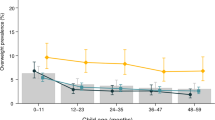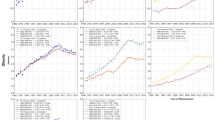Abstract
OBJECTIVE: This study aimed to describe the prevalence of overweight and obesity (OW+O) among Brazilian adolescents and to identify risks for subpopulations defined according to the five country macro-regions and situation (urban–rural) of the domiciles, income, years of school attendance, age and sex.
DESIGN: A nationwide home-based survey representative of the Brazilian civilian noninstitutionalized population, performed in 1989.
METHODS: The sampling plans followed a stratified, multistage, probability cluster design in The National Research of Health and Nutrition sample, which collected anthropometric data of 14,455 domiciles. In all, 13,715 adolescents ranging from 10 to 19 y of age were studied. The OW+O was defined from a body mass index (BMI) equal or superior to the 85th percentile of the reference population of the NCHS. The prevalences in the different studied groups were compared using the adjusted odds ratio in logistic regression models.
RESULTS: The prevalence of OW+O was of 7.7%, reaching 10.6% within the female group and 4.8% within the male group. A direct relation could be established between the socioeconomic level and OW+O. Adolescents of the most industrialized region of the country presented a risk of OW+O 1.86 (95% CI 1.51–2.30) times higher than that found in the least developed region. Male youngsters who lived in urban areas were more liable (OR=1.71, 95% CI 1.30–2.25) to overweight than their counterparts of rural areas. The occurrence of menarche increased two and a half times (OR=2.58, 95% CI 2.11–3.15) the risk of OW+O within the female group of adolescents.
CONCLUSIONS: The results demonstrate a low prevalence of OW+O among Brazilian adolescents when compared with adolescents of more industrialized regions. The OW+O is twice as high within the female group, which represents a much greater difference than the one encountered in industrialized countries, probably owing to the muscular work carried out preponderantly by male adolescents of lower socioeconomic levels. Higher prevalences in subpopulations of higher socioeconomic level and of more industrialized regions show the great need for differentiated actions to control overweight and obesity in the country.
This is a preview of subscription content, access via your institution
Access options
Subscribe to this journal
Receive 12 print issues and online access
$259.00 per year
only $21.58 per issue
Buy this article
- Purchase on Springer Link
- Instant access to full article PDF
Prices may be subject to local taxes which are calculated during checkout

Similar content being viewed by others
References
WHO Working Group . Use and interpretation of anthropometric indicators of nutritional status Bull WHO 1986 64: 929–941.
Kurz MK . Adolescent nutritional status in developing countries Proc Nutr Soc 1996 55: 321–331.
WHO Expert Committee . Physical status: the use and interpretation of anthropometry World Health Organization Technical Report Series, no. 854 Geneva: World Health Organization 1995.
World Health Organization . Obesity: preventing and managing the global epidemic Report of the WHO Consultation on Obesity Geneva: WHO 1998.
Popkin BM . The nutrition transition in low-income countries: an emerging crisis Nutr Rev 1994 52: 285–298.
Must A, Jaques PF, Dallal GE, Bajema CJ, Dietz WH . Long term morbidity and mortality of overweight adolescents: a follow-up of the Harvard growth study of 1922 to 1935 N Engl J Med 1992 327: 1350–1355.
Gortmaker SL, Must A, Perrin JM, Sobol AM, Dietz WH . Social and economic consequences of overweight in adolescence and young adulthood N Engl J Med 1993 329: 1008–1012.
Instituto Nacional de Alimentação e Nutrição . Pesquisa Nacional Sobre Saúde e Nutrição (PNSN) Brasília 1990 (resultados preliminares).
Fletcher PR . PNSN-Plano de amostragem OIT: Brasília, DF 1987.
Coitinho DC, Leão mm, Recine E, Sichieri R . Condições nutricionais da população brasileira: adultos e idosos (Pesquisa Nacional Sobre Saúde e Nutrição) MS/INAN: Brasília 1991.
Kleinbaum DG, Kupper LL, Muller KE, Nizam A . Applied regression analysis and other multivariable methods, 3rd ed Duxbury Press: New York 1998.
CDC, Department of Health and Human Services, Public Health Service, Centers for Disease Control and Prevention . Prevalence of overweight among adolescents: United States, 1988–1991 Morbid Mortal Weekly Rep 1994 43: 818–821.
Troiano RP, Flegal KM, Kuczmarski RJ, Campbell SM, Johnson CL . Overweight prevalence and trends for children and adolescents Arch Pediatr Adolesc Med 1995 149: 1085–1091.
Al-Nuaim AR, Al-Rubeaan K, Al-Mazrou Y, Al-Attas O, Al-Daghari N, Khoja T . High prevalence of overweight and obesity in Saudi Arabia Int J Obes Relat Metab Disord 1996 20: 547–552.
Broussard BA, Johnson A, Himes JH, Story M, Fichtner R, Hauck F, Bachman-Carter R, Hayes J, Frohlich K, Gray N, Valway S, Gohdes D . Prevalence of obesity in American Indians and Alaska natives Am J Clin Nutr 1991 53: 1535S–1542S.
Forbes GB . Nutrition and growth J Pediatr 1977 91: 40–42.
Poskitt EME . The fat child. In Brooks CGD. Clinical paediatric endocrinology 2nd edn. Blackwell Scientific Publication: Oxford 1989 143–165.
Meredith CN, Dwyer JT . Nutrition and exercise: effects on adolescent health Ann Rev Public Health 1991 12: 309–333.
CDC . Vigorous physical activity among high school students—United States, 1990 Morbid Mortal Weekly Rep 1992 41: 33–35.
Diguiseppi C, Roberts I, Li L . Influence of changing travel patterns on child death rates from injury: trend analysis BMJ 1997 314: 710–713.
Sobal J, Stunkard AJ . Socioeconomic status and obesity: a review of the literature Psychol Bull 1989 105: 260–275.
Popkin BM, Richards MK, Montiero CA . Stunting is associated with overweight in children of four nations that are undergoing the nutrition transition J Nutr 1996 126: 3009–3016.
Akesode FA, Ajibode HA . Prevalence of obesity among nigerian school children Soc Sci Med 1983 17: 107–111.
Mendonza HR, Pérez C, Díaz C, Pérez R, Guerrero A, Guzmán V . Sobrepeso y obesidad en adolescentes dominicanos de alto nivel socioeconómico Arch Domin Pediatr 1990 26: 45–50.
Drewnowski A, Popkin BM . The nutrition transition: new trends in the global diet Nutr Rev 1997 55: 31–43.
Taddei JAAC . Epidemiologia da Obesidade na Infância. In Fisberg M Obesidade na Infância e na Adolescência Fundação BYK: São Paulo 1995.
UNDP . Human development report Oxford University Press: New York 1999.
Knishkowy BN, Palti H, Adler B, Gofin R . A follow-up study of adiposity and growth of Jerusalem schoolchildren from age 6 to 14 y J Adolesc Health Care 1989 10: 192–199.
Miller FJW, Billewicz WZ, Thomson AM . Growth from birth to adult life of 442 newcastle upon tyne children Br J Prev Soc Med 1972 26: 224–230.
Frisch RE, Revelle R . The height and weight of girls and boys at the time of initiation of the adolescent growth spurt in height and weight and the relationship to menarche Hum Biol 1971 43: 140–159.
Mossberg HO . 40-year follow-up of overweight children Lancet 1989 26: 491–493.
Di Pietro L, Mossberg HO, Stunkard A . A 40-year history of overweight children in Stockholm: life-time overweight, morbidity, and mortality Int J Obes Relat Metab Disord 1994 18: 585–590.
Rimm IJ, Rimm AA . Association between juvenile onset obesity and severe adult obesity in 73,532 women Am J Public Health 1976 66: 479–481.
Author information
Authors and Affiliations
Corresponding author
Rights and permissions
About this article
Cite this article
Neutzling, M., Taddei, J., Rodrigues, E. et al. Overweight and obesity in Brazilian adolescents. Int J Obes 24, 869–874 (2000). https://doi.org/10.1038/sj.ijo.0801245
Received:
Revised:
Accepted:
Published:
Issue Date:
DOI: https://doi.org/10.1038/sj.ijo.0801245
Keywords
This article is cited by
-
Prevalence and associated factors of childhood overweight/obesity among primary school children in urban Nepal
BMC Public Health (2019)
-
Comparison of three criteria for overweight and obesity classification in brazilian adolescents
Nutrition Journal (2013)
-
Childhood Obesity and the Metabolic Syndrome in Developing Countries
The Indian Journal of Pediatrics (2013)
-
Prevalence of overweight, obesity, and associated risk factors among school children and adolescents in Tianjin, China
European Journal of Pediatrics (2012)
-
Prévalence de l’obésité de l’enfant et de l’adolescent en milieu scolaire à Dakar
Bulletin de la Société de pathologie exotique (2011)



